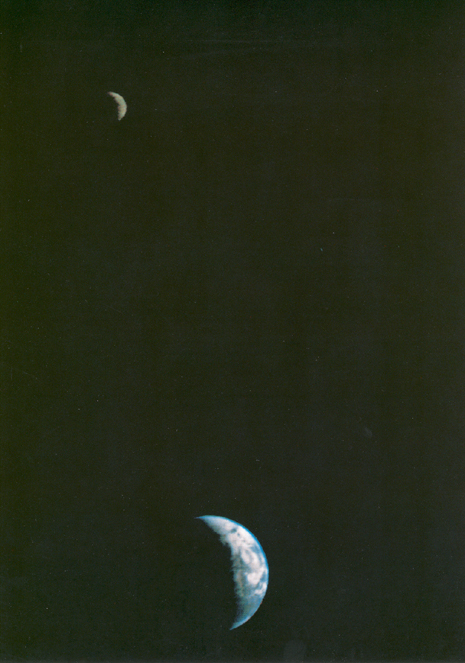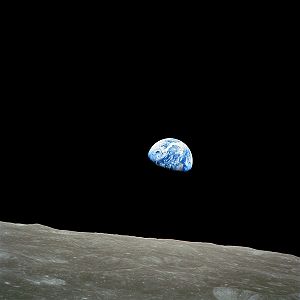Fall Waning Autumn Moon
“Trying to determine what is going on in the world by reading newspapers is like trying to  tell the time by watching the second hand of a clock.” – Ben Hecht
tell the time by watching the second hand of a clock.” – Ben Hecht
Keyhole history. A standard assumption among historians. Decades, even centuries, must pass before we can determine the relevance of particular events in the flow of human history. Anything said, for example, about the George W. Bush presidency, relies more on bias and hunch that on historical context.
We judge poorly when we judge matters in which we have had some part, even if the part were only reading newspapers. Hecht’s comment tells the story with a great metaphor.
(This picture of the Earth and Moon in a single frame, the first of its kind ever taken by a spacecraft, was recorded September 18, 1977, by NASAs Voyager 1 when it was 7.25 million miles (11.66 million kilometers) from Earth. The moon is at the top of the picture and beyond the Earth as viewed by Voyager. In the picture are eastern Asia, the western Pacific Ocean and part of the Arctic. Voyager 1 was directly above Mt. Everest (on the night side of the planet at 25 degrees north latitude) when the picture was taken. Voyager 1 was launched September 5, 1977 and Voyager 2 on August 20, 1977. JPL is responsible for the Voyager mission.)
Having said all that, let me give you two instances in which keyhole history does not have wait. These photographs, amazing images, show historical moments that need no time to pass before their significance becomes clear. 
Here humanity achieves a perspective never before possible. Ever. Not in the entire history of the human race. A view of earth from the surface of the moon, the famous 1968 shot by astronaut William Anders, and a God’s eye perspective, looking at our home and its sole satellite in one and the same moment.
Around 60,000 years ago or so homo sapiens left Africa, bound for other continents. Over the next 45, 000 years this African animal had made its way onto all the continents of our planet and many of its islands. Since then, we have populated these land masses.
(World map of human migrations, with the North Pole at center. Africa, harboring the start of the migration, is at the bottom right and South America at the far left. Migration patterns are based on studies of mitochondrial (matrilinear) DNA. Numbers represent thousand years before present. The blue line represents area covered in ice or tundra during the last great ice age. The letters are the mitochondrial DNA haplogroups (pure motherly lineages))
Over the last 60,000 years our species has explored the planet’s nooks and crannies (at least those above the surface of the ocean), but in all that time we could never look at our planet whole. We saw only parts at any one time, we looked at the second hands of earth’s totality.
We could see the moon whole, sort of, but we could never see our own home in the same way. With William Anders earthrise photograph and the Voyager shot of the earth and moon, our human perspective could position earth and its satellite in the cosmos not through abstract conjecture but by simple visual observation.
Not only were we finally and truly out of Africa, we had gone beyond our planet’s comfortable precincts and into the unimaginable distances of space itself.
No, there is no need to wait on the historical significance of these photographs, we knew it the instant we saw them.
